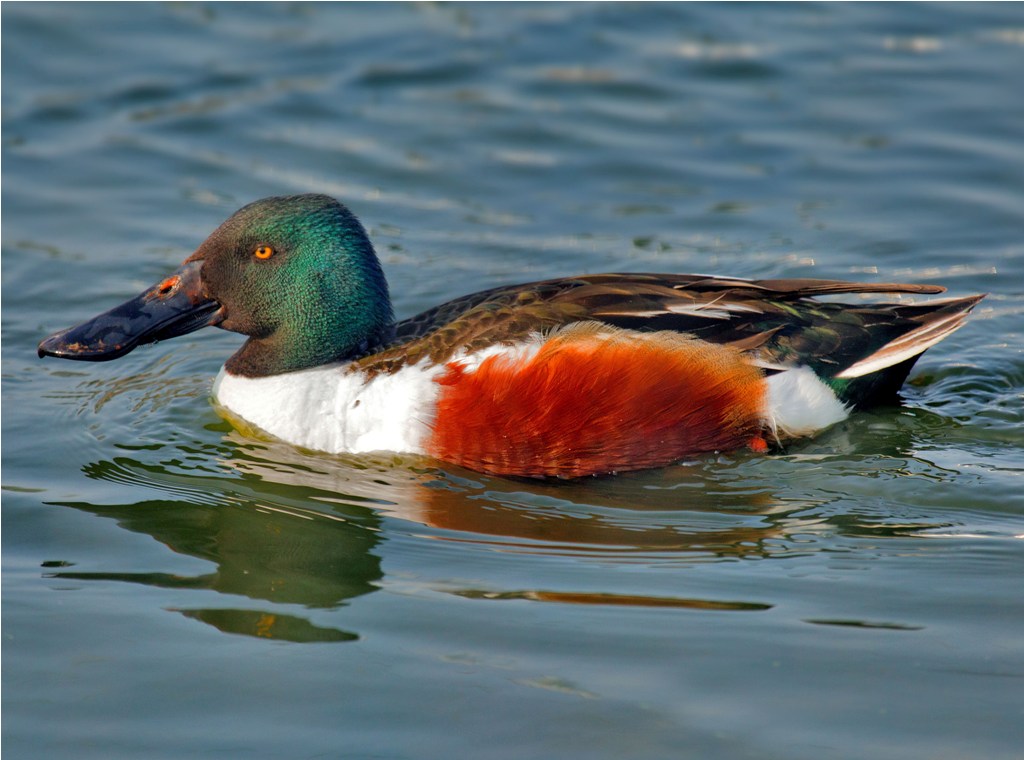
Northern shoveler(Anas clypeata)
Phylum —chordata
Class — aves
Order — anseriformes
Family — anatidae
Genus –anas
Appearance
This species is unmistakable due to its large spatulate bill. The breeding drake has an iridescent dark green head, white breast and chestnut belly and flanks. In flight, pale blue forewing feathers are revealed, separated from the green speculum by a white border. In early fall the male will have a white crescent on each side of the face. In non-breeding (eclipse) plumage, the drake resembles the female.
The female is a drab mottled brown like other dabblers, with plumage much like a female mallard, but easily distinguished by the long broad bill, which is gray tinged with orange on cutting edge and lower mandible. The female's forewing is gray.
They are 48 cm (19 in) long and have a wingspan of 76 cm (30 in) with a weight of 600 g (1.3 lb).
Habitat
Northern shovelers has a very broad geographical range. They breed throughout Eurasia and western North America. They are also found in the Great Lakes region of the eastern United States. In winter various populations migrate south to specific locations, scattered throughout north-east Africa, India, Southern China and Japan to Mexico and southern North America.
Behavior
Northern shovelers stay in small groups of up to twenty, but they may travel in larger numbers during migration. They are quiet birds that tolerate human presence and can be relatively tame.
Diet
A northern shoveler feeds mainly by drawing water into its bill and then pumping it out through the sides with their tongue, filtering out minute food particles with long comb-like lamellae that line the edge of the bill. The particles mainly consist of tiny crustaceans, mollusks, insects, and their larvae as well as seeds and pieces of leaves and stems of plants. In addition to the food particles they also eat water beetles, small minnows, and snails.
Reproduction
Breeding usually takes place from April until June. Nests are made on dry land close to fresh water and they are built of grasses and lined with down feathers. The female builds the nest by forming a neat cup by twisting her body on the ground. She lays between 9 and 11 eggs. The eggs are olive colored and 52x37mm. Incubation by the female alone begins immediately after all the eggs are laid and can last 23 to 25 days.
In captivity
Lifespan in captivity is up to 30 years.
It is not difficult to keep northern shovelers. In summer, they are kept in outdoor enclosures. The minimum size of the enclosure is 4 square meters: one meter fora bird.
In the cold season, birds are kept in sections of the poultry house. Access to paddocks is open only on warm, windless, sunny days and only during the daytime.
Wild ducks become restless in the fall, when they fly south seasonally, and may join other wild ducks and fly away with them, so you should trim their wings in time or restrict access to walking. You can also cover the paddock with a net.
For winter keeping of ducks any shed (paddock) in which they are protected from wind and precipitation is suitable. The pen for ducks is built in such a way that one duck has at least 1 sq. m. of area with a room of the height of 70-100 cm. Ducks are not afraid of the cold; if they are full, clean and healthy, they can easily live at any frost.
The area of the paddock should not be less than the area of the paddock shed itself. One duck needs a range of 4 sq. m.In this case, all winter it is necessary to maintain a sufficient mirror of the reservoir for birds, not covered with ice. This is achieved in various ways, one of which may be the use of an air compressor. Long hoses from the compressor that pumps air are lowered to the bottom of the reservoir, and air bubbles, rising up, carry warmer water. With constant mixing of warm water from the lower layers of the reservoir with colder water from the surface, the possibility of ice formation is eliminated even in the most severe frosts.
As a winter bedding for waterfowl, you can use soft hay, which is laid out in places where birds rest.
The diet of the northern shoveler includes grain feed-corn, wheat, barley, millet, oatmeal, wheat bran, grass, meat and fish meal, chalk, small shell, gammarus. In the warm season, it is good to give various greens - cut dandelion leaves, lettuce, plantain, duckweed. Good food for ducks - wet mixture of grated carrots, bran, various cereals. During the reproductive period and during molting, they are mixed with wet food or given separately: fish and minced meat.The diet should be with the proportion of organic and vegetable feed 1/1.
Northern shovelers are friendly to other birds, so they can be kept on the same pond with other ducks.
Artificial shelters for nests are installed in the paddock. Ducks independently incubate, breed and raise young ducklings.
 Russian
Russian
 English
English























